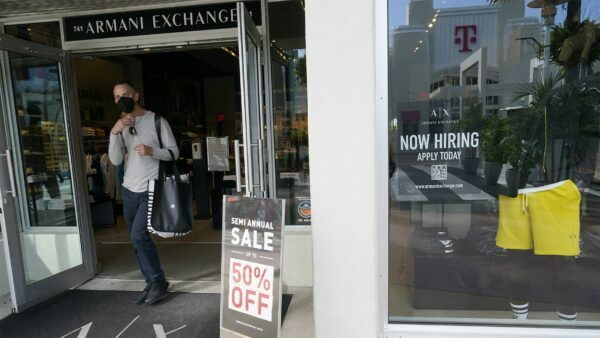In a light sign for the U.S. economy, organizations moved forward their recruiting last month as omicron blurred and more Americans branched out to spend at eateries, shops and lodgings notwithstanding flooding expansion.
U.S. organizations moved forward their recruiting last month as the omicron blurred and more Americans branched out to spend at cafés, shops, and lodgings notwithstanding flooding expansion.
Bosses added a vigorous 678,000 positions in February, the biggest month to month complete since July, the Labor Department detailed Friday. The joblessness rate dropped to 3.8%, from 4% in January, expanding a sharp decrease in joblessness to its most minimal level since before the pandemic emitted two years prior.
Friday’s recruiting figures were gathered before Russia’s intrusion of Ukraine, which has sent oil costs bouncing and has increased dangers and vulnerabilities for economies in Europe and the remainder of the world.
“All signs are that the pandemic is facilitating its hang on positions and the economy,” said Jane Oates, leader of WorkingNation and a previous Labor Department official. “Exceptionally solid numbers in extremely questionable times.”
However the February recruiting information propose that two years after COVID-19 started a cross country closure and 22 million employment misfortunes, the illness is losing its hold on America’s economy. More individuals are taking position or looking for work – a pattern that, assuming it suffers, will assist with facilitating the work deficiencies that have perplexed businesses for as long as year.
All things considered, raising expenses for gas, wheat and metals, for example, aluminum, which are traded by both Ukraine and Russia, will probably speed up expansion before very long. More exorbitant costs and nerves encompassing the conflict could slow recruiting and development in the not so distant future, however market analysts anticipate that the results should be more serious in Europe than in the United States.
Other late monetary information additionally show the economy keeping up with strength as new COVID-19 contaminations have plunged. Purchaser spending has risen, prodded by higher wages and investment funds. Eatery traffic has recaptured pre-pandemic levels, lodging reservations are up and undeniably a bigger number of Americans are flying than at the tallness of omicron.
Also, less individuals are presently working remotely a direct result of the illness. A proceeding with stream of individuals back to workplaces could help work in metropolitan midtowns. What’s more the quantity of Americans who are postponing pursuits of employment inspired by a paranoid fear of the illness fell strongly from January, when omicron was seething, to February.
Expansion has as of now arrived at its most elevated level starting around 1982, with cost spikes particularly high for such necessities as food, gas and lease. Accordingly, the Federal Reserve is set to raise financing costs a few times this year starting not long from now. Those increments will ultimately mean higher acquiring rates for buyers and organizations, including for homes, automobiles and charge cards.
One figure in Friday’s report could give consolation to the Fed’s policymakers as they evaluate expansion pressures: Average time-based compensation scarcely filled in February. Higher wages, while really great for laborers, regularly lead organizations to raise costs to take care of their higher work costs and along these lines further elevate expansion.
Seat Jerome Powell said for the current week he intends to suggest that the Fed raise its benchmark transient rate by a quarter-moment that it meets in around fourteen days. Powell has recognized that high expansion has demonstrated more persevering and has spread more comprehensively than he and numerous financial specialists had anticipated.
A review by The Associated Press-NORC Center for Public Affairs Research observed that Americans are currently considerably less stressed over COVID-19 than they were in December and January. Cover commands and different limitations are finishing.
The organization, which utilizes around 75, has four employment opportunities in information examination, designing and promoting. By far most of its clients do the organization’s exclusive exercises at home. Throughout recent months, Ms. Cartwright has recruited 15 individuals, 10 of whom supplanted laborers who had stopped. Stopping has arrived at record levels broadly as businesses needing employs have poached laborers from different organizations.
The quantity of individuals who said they kept away from work hunting since they were worried about COVID-19 tumbled to 1.2 million in February, down 600,000 from January, when omicron was seething.
Among the new position searchers was Ryan Gerard, who had stopped a deals work last July since he felt wore out by the messages and messages he got at the entire hours and in light of the fact that his manager wasn’t completely OK with remote work during COVID-19.
Accordingly, Ms. Cartwright said, p.volve has given salary increases and more administration potential chances to attempt to hold its workers. The organization is situated in New York City however has likewise employed from a distance since the pandemic hit, fundamentally extending its ability pool.
As cover orders have finished and omicron cases have declined, client visits have dramatically increased at p.volve, an internet based wellness organization that gives at-home exercises and has three rec centers in New York, Los Angeles and Chicago, said Julie Cartwright, the organization’s leader.
Ray Canaan is the author of Funds Management and he is Best writer and He has a particular interest covering digital strategy, leadership, enterprise culture, and diversity. Canaan meets regularly with Chief Information Officers and other business technology executives to discuss world issues and keep on top of news trends.
Disclaimer: The views, suggestions, and opinions expressed here are the sole responsibility of the experts. No FUNDS MANAGEMENT journalist was involved in the writing and production of this article.

